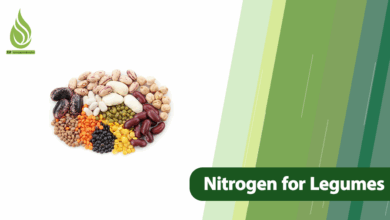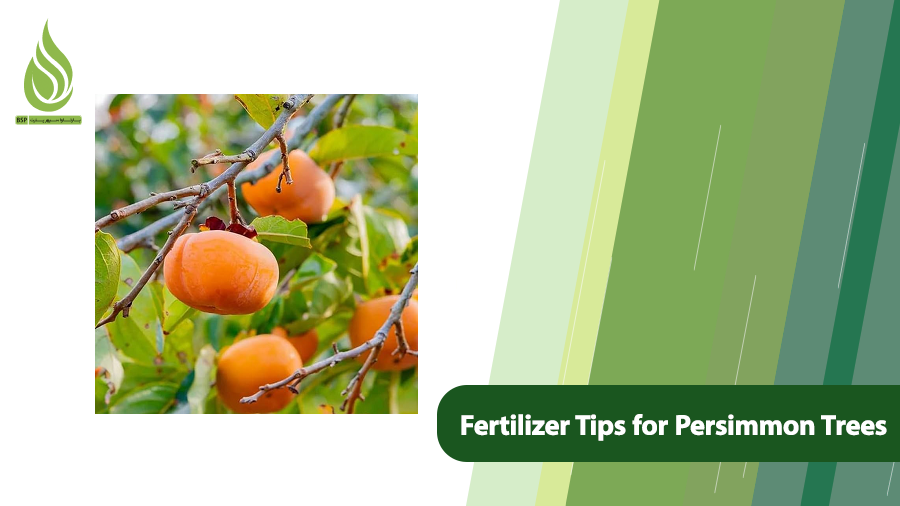
Requirements and Fertilizer Tips for Persimmon Trees
Persimmons are delicious and nutritious fruits that many people love. To achieve the best yields and enhance the quality of the fruit, farmers need to understand the essential conditions for growing persimmons. Key factors for successful cultivation include the right climate, soil type, adequate sunlight, proper irrigation, and knowledge of suitable fertilizer for persimmon trees. Additionally, timing is crucial when it comes to feeding the trees, as it significantly affects both the quantity and quality of the fruit. In this article, we will explore the necessary conditions for growing persimmon trees and introduce the fertilizer that can lead to better productivity.
Essential Conditions for Growing Persimmon Trees
To successfully grow persimmon trees, certain conditions must be met:
- Temperature: Persimmon trees thrive in warm, moderate climates. They grow best in areas with hot summers and mild winters, ideally at temperatures between 68°F and 86°F (20°C to 30°C). While these trees can tolerate cooler temperatures, they do not do well with harsh winters or severe frost if you want them to produce fruit.
- Sunlight: Persimmon trees need direct sunlight and should be planted in sunny locations. Shade can harm the tree’s growth and fruit production.
- Humidity: These trees require moderate humidity. Too much moisture can lead to fungal diseases and root rot.
- Watering: Regular watering is crucial, especially when you are dealing with agriculture in drought. It’s important to provide enough water without overwatering, which can cause root rot. Drip irrigation works best for persimmon trees. They need annual rainfall of about 28 to 47 inches (700 to 1200 mm), distributed evenly throughout the year for optimal water supply.
- Location: The planting site should protect the trees from strong winds and cold temperatures. It’s also important to maintain proper spacing between trees to prevent shading and competition for resources.
- Soil Type: Choosing the right soil for persimmon trees is vital. The soil should allow water to drain well to avoid waterlogging and root rot. Loamy soils, which are a mix of sand, silt, and clay, are ideal. Heavy, clayey soils usually have poor drainage and are not suitable. The soil should also be rich in organic matter to help the roots absorb the necessary nutrients, which can be enhanced with persimmon tree fertilizer.
- Soil pH: The soil’s pH level should be between 6 and 7. This range helps with nutrient absorption and creates a suitable environment for root growth.
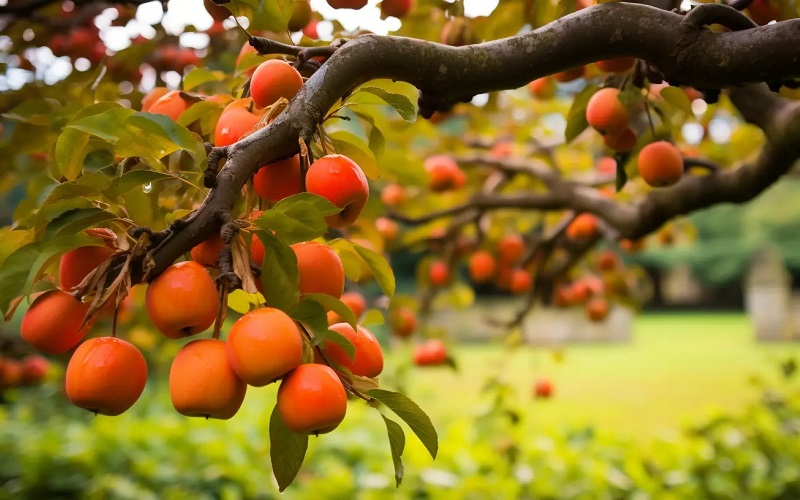
The Importance of Proper Nutrition for Persimmon Trees
Proper nutrition is crucial for the growth, health, and fruit production of persimmon trees. Here are a few reasons why it’s so important:
- Faster and Healthier Growth: Adequate nutrition leads to quicker and healthier growth of persimmon trees.
- Quality Fruit Production: Persimmon trees need enough nutrients to produce high-quality and abundant fruits.
- Stronger Immune Systems: Using the right fertilizers helps strengthen the trees’ immune systems. Healthier trees are less susceptible to diseases and pests.
- Impact on Fruit Quality: The right nutrients directly affect the taste, color, and size of the fruits.
In summary, using appropriate fertilizer and ensuring proper nutrition for persimmon trees is essential for achieving high yields and excellent fruit quality. By maintaining the right balance of nutrients, you can enhance both the productivity and health of the trees.
Choosing the Right Fertilizer for Persimmon Trees
Fertilizing is an important part of maximizing the productivity of persimmon trees. Using the right fertilizer can boost crop yields and improve fruit quality. Fertilizers provide the essential nutrients that trees need to thrive. Like all fruit trees, persimmons require a variety of nutrients.
Fertilizing persimmon trees can be done with organic and mineral fertilizer. Organic fertilizers—such as cow manure, chicken manure, fish fertilizer, and compost—supply nutrients to the soil and enhance its structure. These fertilizers provide a sustainable source of the nutrients trees need. Sometimes, however, specific amounts of certain nutrients are necessary to address deficiencies in the trees. In these cases, mineral fertilizers are used, which contain a mix of both micro and macro elements.
Here are some essential fertilizers for the growth and productivity of persimmon trees:
- Nitrogen: Nitrogen is a key nutrient for plant growth. It helps produce chlorophyll and plays a vital role in photosynthesis. Using nitrogen fertilizer promotes growth in the tree, branches, and leaves. Examples of nitrogen-rich fertilizers include ammonium sulfate and urea. A nitrogen deficiency can lead to yellowing leaves and stunted growth.
- Phosphorus: Phosphorus aids in root development, flower and fruit production, and enhancing fruit quality. It also plays a role in energy processes within the plant. Phosphate fertilizers, such as diammonium phosphate or sodium superphosphate, are good sources of phosphorus.
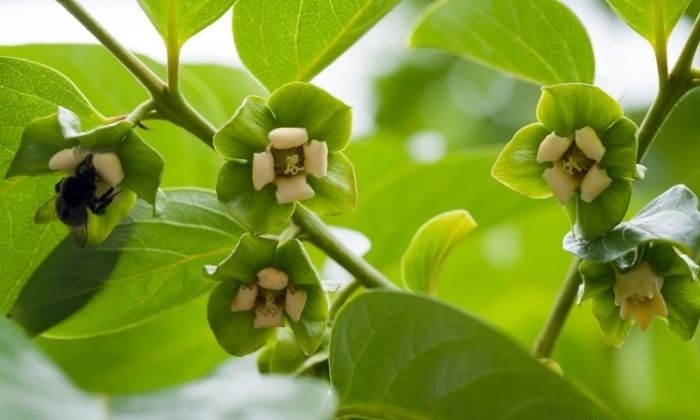
- Potassium: Potassium helps regulate water within the tree and strengthens its immune system. It also plays a role in improving the taste and quality of the fruit and encourages more flowering. Good sources of potassium include potassium chloride and potassium sulfate.
- Calcium: Calcium strengthens the cell walls and helps maintain the structure of the roots. A lack of calcium can lead to uneven fruit development. Lime and calcium-rich fertilizers can provide the necessary calcium for the trees.
- Magnesium: Magnesium is part of chlorophyll and is essential for photosynthesis. It also aids in the absorption of nitrogen and other nutrients. A deficiency in magnesium can cause leaves to turn yellow or red. Magnesium fertilizers, such as magnesium sulfate, can help supply this important nutrient.
- Other Elements: In addition to the main nutrients mentioned, persimmon trees require other trace elements like iron, copper, and zinc. Although these micronutrients are needed in smaller amounts, they play crucial roles in the plant’s physiological processes. For example, iron is essential for chlorophyll production and photosynthesis. A deficiency of iron can lead to yellowing leaves.
Understanding Your Persimmon Tree’s Needs Before using Fertilizer
Before fertilizing your persimmon trees, it’s crucial to understand their specific needs. Knowing what your tree requires can help you avoid unnecessary expenses and ensure that you provide the right nutrients. By accurately identifying the needs of your persimmon tree, you can fertilize effectively, promoting healthy growth and high fruit production.
To determine the nutritional needs of the tree, you should analyze the soil. A soil test will assess the soil’s pH and nutrient levels, helping you understand what elements and how much of each are needed. Keep in mind that a tree’s nutrient requirements can vary based on factors such as climate, age, and soil type. For instance, younger trees may need more nitrogen, while mature trees often require more potassium and phosphorus.
The amount of fertilizer and the timing of application can change depending on the climate, soil type, and age of the persimmon tree. It’s a good idea to consult with an experienced farmer or agricultural expert to identify the right type and amount of fertilizer to use. Some laboratories provide soil test results along with recommendations for fertilization, including how much and how to apply different nutrients. If you’re not comfortable interpreting the test results, seeking guidance from an agricultural expert is a smart choice.
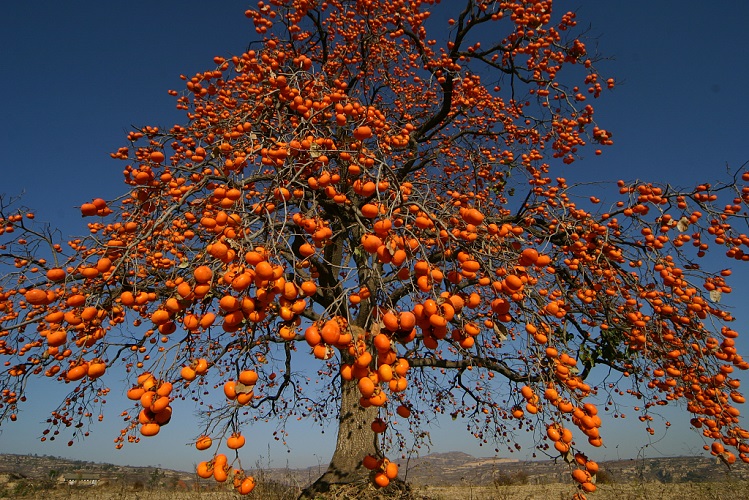
Timing for Applying Fertilizer to Persimmon Trees
Persimmon trees have specific nutritional needs at different stages of their growth. It’s important to provide the right nutrients at the right time. Here’s a normal fertilization schedule for persimmon trees:
- Early Spring (Beginning of Growth Period)
- Goal: Support new growth and prepare the tree for the growing season. This fertilization can be done using a starter solution.
- Type of Fertilizer: Use nitrogen-rich and balanced fertilizers (N-P-K) to encourage the growth of buds and leaves.
- Before Flowering
- Goal: Strengthen the roots and increase flower production.
- Type of Fertilizer: Phosphate fertilizers, like superphosphate, are suitable for this stage. They should be applied about 2 to 3 weeks before flowering.
- When Fruit Begins to Form
- Goal: Improve fruit quality and increase yield.
- Type of Fertilizer: Potassium fertilizers should be added to support fruit development and enhance flavor and color. Apply these fertilizers when the fruit starts to form.
- Early Summer
- Goal: Continue to nourish the tree and support fruit growth.
- Type of Fertilizer: Balanced fertilizers (N-P-K) or specialized fertilizers can be used to provide necessary nutrients. Fertilizing at this time can be beneficial if you notice signs of nutrient deficiency.
- Fall
- Goal: Improve soil quality and supply nutrients for the winter season. Fertilizers should be applied after the harvest to give the soil enough time to break down and absorb the nutrients.
- Type of Fertilizer: Organic manure, such as compost or animal manure, are ideal for this time.
By following this schedule and using the right fertilizer, you can help ensure that your persimmon trees receive the nutrients they need at each stage of growth, leading to healthier trees and better fruit production.
